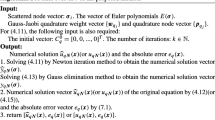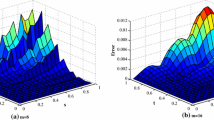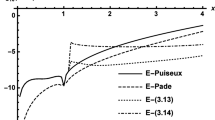Abstract
Numerical methods for weakly singular Volterra integral equations with non-linear dependencies between unknowns and their integrals, are almost non-existent in the literature. In the present work an adaptive Huber method for such equations is proposed, by extending the method previously formulated for the first kind Abel equations. The method is tested on example integral equations involving integrals with kernels K(t, τ) = (t − τ)−1/2, K(t, τ) = exp[−λ(t − τ)](t − τ)−1/2 (where λ > 0), and K(t, τ) = 1. By controlling estimated local discretisation errors, the integral equation can be solved adaptively on a discrete grid of nodes in the independent variable domain, in a step-by-step fashion. The practical accuracy order is close to 2. The accuracy can be varied by varying the prescribed local error tolerance parameter tol, although the actual errors tend to be larger than tol. Approximations to off-nodal solution values can also be computed, with a comparable accuracy. The method appears numerically stable when partial derivatives, of the non-linear function representing the equation, with respect to the unknown and its integral(s), are of the same sign. The stability of the method in the opposite case may be debated.
Similar content being viewed by others
Explore related subjects
Discover the latest articles and news from researchers in related subjects, suggested using machine learning.References
Bieniasz LK (2008) An adaptive Huber method with local error control, for the numerical solution of the first kind Abel integral equations. Computing 83: 25–39
Bieniasz LK (2008) Initialisation of the adaptive Huber method for solving the first kind Abel integral equation. Computing 83: 163–174
Bieniasz LK (2008) Cyclic voltammetric current functions determined with a prescribed accuracy by the adaptive Huber method for Abel integral equations. Anal Chem 80: 9659–9665
Bieniasz LK (1992) ELSIM-A user-friendly PC program for electrochemical kinetic simulations. version 1.0-solution of integral equations for linear scan and cyclic voltammetry. Comput Chem 16: 11–14
Bieniasz LK (1993) An efficient numerical method of solving integral equations for cyclic voltammetry. J Electroanal Chem 347: 15–30
De Vries WT (1968) Distortion of constant-current chronopotentiograms by double-layer charging. J Electroanal Chem 17: 31–43
Nicholson RS, Shain I (1964) Theory of stationary electrode polarography, single scan and cyclic methods applied to reversible, irreversible, and kinetic systems. Anal Chem 36: 706–723
Nicholson RS (1965) Some examples of the numerical solution of nonlinear integral equations. Anal Chem 37: 667–671
Nicholson RS, Olmstead ML (1972) Numerical solution of integral equations. In: Mattson JS, Mark HB Jr, MacDonald HC Jr (eds) Computers in chemistry and instrumentation, vol 2, Electrochemistry, calculations, simulation, and instrumentation. Marcel Dekker, New York, pp 119–138
Olmstead ML, Nicholson RS (1968) Influence of double-layer charging in chronopotentiometry. J Phys Chem 72: 1650–1656
Brunner H, van der Houwen PJ (1986) The numerical solution of Volterra equations. North-Holland, Amsterdam
Brunner H (2004) Collocation methods for Volterra integral and related functional differential equations. Cambridge University Press, Cambridge
Linz P (1985) Analytical and numerical methods for Volterra equations. SIAM, Philadelphia
de Hoog F, Weiss R (1973) On the solution of a Volterra integral equation with a weakly singular kernel. SIAM J Math Anal 4: 561–573
Miller RK, Feldstein A (1971) Smoothness of solutions of Volterra integral equations with weakly singular kernels. SIAM J Math Anal 2: 242–258
Huber A (1939) Eine Näherungsmethode zur Auflösung Volterrascher Integralgleichungen. Monatsschr Math Phys 47: 240–246
MATHEMATICA, Wolfram Res. Inc., Champaigne Il. http://www.wolfram.com
Gustafsson K (1994) Control-theoretic techniques for stepsize selection in implicit Runge-Kutta methods. ACM Trans Math Softw 20: 496–517
Cody WJ (1969) Rational Chebyshev approximations for the error function. Math Comput 23: 631–637
Cody WJ, Paciorek KA, Thacher HC Jr (1970) Chebyshev approximations for Dawson’s integral. Math Comput 24: 171–178
Blank L (1996) Stability results for collocation methods for Volterra integral equations. Appl Math Comput 79: 267–288
Schönauer W (2000) Numerical engineering: design of PDE black-box solvers. Math Comput Simul 54: 269–277
Stetter HJ (1980) Modular analysis of numerical software. Lect Notes Math 773: 133–145
Söderlind G, Wang L (2006) Adaptive time-stepping and computational stability. J Comput Appl Math 185: 225–243
Author information
Authors and Affiliations
Corresponding author
Additional information
Communicated by C.C. Douglas.
Rights and permissions
About this article
Cite this article
Bieniasz, L.K. An adaptive Huber method for weakly singular second kind Volterra integral equations with non-linear dependencies between unknowns and their integrals. Computing 87, 35–54 (2010). https://doi.org/10.1007/s00607-009-0074-3
Received:
Accepted:
Published:
Issue Date:
DOI: https://doi.org/10.1007/s00607-009-0074-3
Keywords
- Weakly singular integral equations
- Adaptive methods
- A posteriori error estimation
- Product-integration
- Huber method
- Computational electrochemistry




